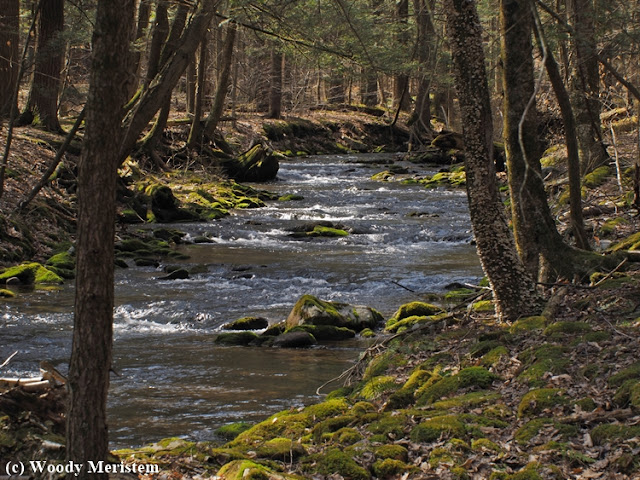The
subject of the last post
on In Forest and Field was a movie made in 1926 which documented the
logging of old growth forest in northwestern Pennsylvania. The post
and movie have raised a number of questions among viewers, questions
that I’ll attempt to answer here.
The
Central Pennsylvania Lumber Company was a subsidiary of the U. S.
Leather Company, a combine of a number of smaller leather
companies that apparently joined to reduce competition and set prices
– typical of many similar monopolies that formed in the late 1800s.
At
the time leather was tanned using tannic acid derived from tree bark,
primarily the bark of hemlocks. To ensure a steady supply of bark
most tanneries purchased large tracts of woodland containing hemlock
forests; when the smaller tanneries combined to form the U. S.
Leather Company, ownership of most of the land was transferred to the
new company. U. S. Leather had
a number of tanneries throughout northern Pennsylvania, all of which
depended on a steady supply of bark.
Initially
U. S. Leather contracted for cutting of the trees and delivering
bark to their tanneries. The
hemlock bark was loaded on modified log cars or wagons for
transport to the tanneries where it was stored until needed.
Contrary
to popular opinion, the peeled hemlock logs were NOT left in the
woods to rot. Because the bark could only be peeled for a short
portion of the year, the logs were transported to mills later in the year
when the loggers were not peeling bark.
The contractors who did the cutting initially sawed the logs and sold the lumber. Realizing the profit to be made from sawing and selling lumber, in 1903 U. S. Leather
terminated the contracts and took over production of lumber from
its lands.
Given
the amount of time devoted to the
“Bull Dozer” in
the movie,
it
must have been the company’s pride and joy. Bulldozers
were first produced commercially in 1923, so CPL was an early
adopter; it would have replaced a large crew of men and horses
devoted
to leveling log landings and constructing railroad grades.
CPL, like almost all of the large logging operators in the late 1800s and early 1900s, used logging railroads to transport logs from the woods to the sawmill. The railroads were often steep and crooked, requiring the use of geared locomotives of which there were three major manufacturers, CPL used locomotives from all three. The most common was the Shay –
Climax locomotives were also frequently used –
The Heisler locomotive was the last geared locomotive to be developed and is the one seen in the movie –
Now
for the loggers’ tools that may require some explanation, in order
of their appearance in the film:
Most
people are familiar with the double-bitted axe that has two cutting
edges. The heads usually weighed 3½ or 4 pounds, occasionally more, and were mounted
(hung) on a hickory or ash handle.
Two
man crosscut saws were of various styles in different areas; the saws
were sharpened differently depending on whether they were used to cut
softwoods or hardwoods or even the season of the year.
Bark
spuds of a variety of designs were used to lever bark off the
underlying wood. Bark is only loose enough to peel in
late-spring and very
early-summer.
A string of logs was hooked together end-to-end with log grabs enabling the logs to be
skidded to a landing behind a team of draft horses.
A log skip's blunt end was used to drive the points of grabs into logs, at the landing the
pointed end was used to easily remove the grab from a log. New skips
are still available, this one needs a wooden handle.
Logs
were branded on the ends to show which jobber did the actual
logging in the woods. The brand's symbols were stamped into the logs' ends, not burned as with cattle brands. Brands were typically recorded in the county
courthouse.
Peaveys
have a spike on the end to push logs and a hook to turn and roll
logs. The peavey was developed by, and named for, a Maine logger of the
same name.
Once
logs were in the log pond they had to be moved around, for this the
pike pole was ideal. They’re a long wooden pole with a spike and
hook at the end, very similar to the medieval weapon called a pike.
The
mill at Sheffield actually had what were in effect two sawmills in
one – they were called “the long side” and “the short side” and sawed logs of different lengths. There was another, separate, sawmill
to produce hardwood lumber.Many of the old sawmill towns also had
ancillary facilities, usually owned by independent companies –
kindling wood factories that made bundles of scrap wood to start
the fire in old cook stoves; clothespin factories; and chemical wood
plants that produced acetic
acid, wood alcohol, acetone and charcoal from hardwood trees too small to be sawn into lumber.
Hopefully
this will answer some questions for those not familiar with old-time
logging.


















%20-%20female%20flower.JPG)


.jpg)












